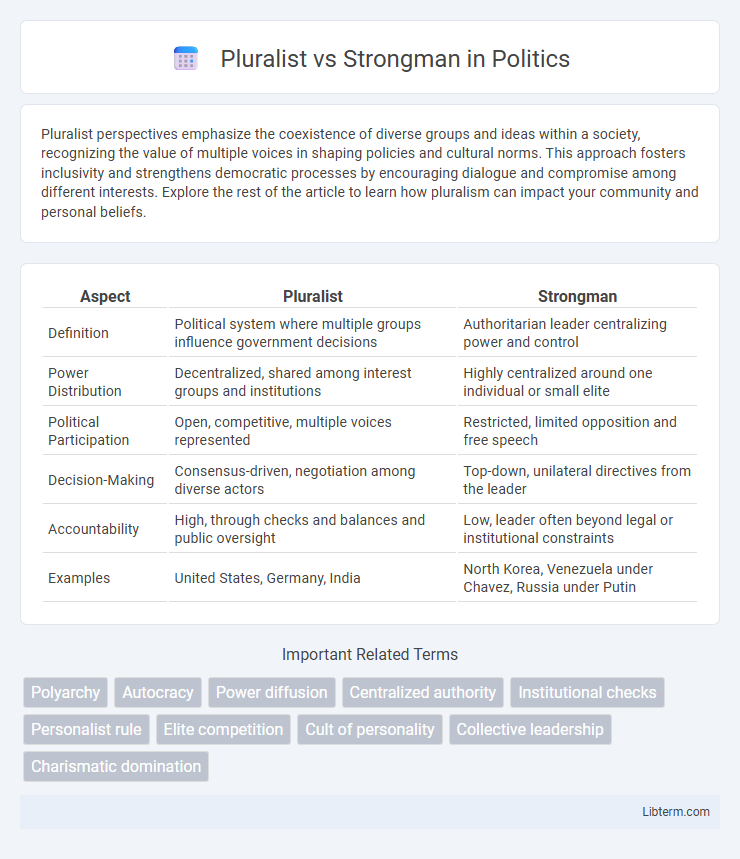Pluralist perspectives emphasize the coexistence of diverse groups and ideas within a society, recognizing the value of multiple voices in shaping policies and cultural norms. This approach fosters inclusivity and strengthens democratic processes by encouraging dialogue and compromise among different interests. Explore the rest of the article to learn how pluralism can impact your community and personal beliefs.
Table of Comparison
| Aspect | Pluralist | Strongman |
|---|---|---|
| Definition | Political system where multiple groups influence government decisions | Authoritarian leader centralizing power and control |
| Power Distribution | Decentralized, shared among interest groups and institutions | Highly centralized around one individual or small elite |
| Political Participation | Open, competitive, multiple voices represented | Restricted, limited opposition and free speech |
| Decision-Making | Consensus-driven, negotiation among diverse actors | Top-down, unilateral directives from the leader |
| Accountability | High, through checks and balances and public oversight | Low, leader often beyond legal or institutional constraints |
| Examples | United States, Germany, India | North Korea, Venezuela under Chavez, Russia under Putin |
Introduction to Political Systems
Pluralist political systems emphasize the distribution of power among various interest groups, allowing diverse voices to influence policy-making within democratic institutions. Strongman regimes centralize authority in the hands of a single leader who exercises significant control over political, military, and social structures, often limiting political pluralism. Understanding these contrasting systems highlights the spectrum of governance models from inclusive, participatory frameworks to authoritarian rule.
Defining Pluralism
Pluralism is defined by the recognition and affirmation of diverse groups and interests within a political system, promoting power dispersion and participation from multiple stakeholders. In contrast to strongman rule, which centralizes authority in a single leader, pluralism ensures that no single entity dominates decision-making processes. This model supports democratic principles by encouraging inclusive governance and protecting minority rights against authoritarian control.
Characteristics of Strongman Rule
Strongman rule is marked by centralized authority where power is concentrated in a single leader who often bypasses institutional checks and balances. This governance style typically features authoritarian decision-making, suppression of political opposition, and control over the military and security forces to maintain dominance. Strongmen rules often rely on populist rhetoric, personal loyalty, and coercion to sustain their regime.
Historical Contexts: Pluralist and Strongman Governments
Pluralist governments emerged primarily in the mid-20th century, characterized by the distribution of power across multiple political institutions and civil society groups, enabling checks and balances that foster democratic governance. Strongman governments, often rooted in post-colonial or authoritarian contexts, concentrate power in a single leader who exercises control over the military and political apparatus to maintain order and suppress opposition. Historical examples include pluralist democracies like post-WWII Western Europe and strongman regimes in Latin America and Africa during the Cold War, reflecting divergent responses to political instability and development challenges.
Power Distribution: Shared vs Centralized
Pluralist systems emphasize shared power distribution through multiple centers of influence, such as legislative bodies, independent institutions, and civil society organizations, promoting checks and balances. Strongman regimes centralize power tightly around a single leader or ruling party, minimizing institutional autonomy and concentrating authority to enforce unilateral decisions. This centralization often leads to limited political pluralism and reduced accountability compared to pluralist governance frameworks.
Decision-Making Processes in Both Models
Pluralist decision-making processes involve multiple stakeholders, encouraging negotiation and consensus-building across diverse groups to balance power and interests. Strongman models centralize authority, enabling swift, unilateral decisions often driven by a single leader's vision or directives. The pluralist framework tends to prioritize deliberation and inclusivity, whereas strongman approaches emphasize efficiency and control in governance.
Societal Impact: Stability and Freedom
Pluralist systems promote societal stability through inclusive governance and dispersed power, allowing diverse groups to influence decision-making and protect individual freedoms. Strongman regimes often enforce order via centralized authority and coercion, which can suppress dissent and limit personal liberties. The trade-off between stability and freedom highlights the pluralist preference for democratic participation versus the strongman's prioritization of control and security.
Case Studies: Examples from Around the World
Pluralist democracies, exemplified by countries like Canada and Germany, showcase power-sharing mechanisms, competitive elections, and respect for civil liberties, fostering inclusive governance. In contrast, strongman regimes such as Russia under Vladimir Putin and Turkey under Recep Tayyip Erdogan illustrate centralized authority, limited political competition, and constrained media freedom, often justifying control through national security or stability concerns. Case studies from Southeast Asia, including Singapore's blend of meritocratic pluralism and firm political control, highlight the complex spectrum between pluralism and authoritarianism in contemporary political systems.
Strengths and Weaknesses Compared
Pluralist leadership thrives on collaboration and diverse perspectives, fostering innovation and adaptability but can struggle with slow decision-making and potential conflicts. Strongman leadership excels in decisive, top-down control, promoting clear direction and rapid action, yet risks authoritarianism and stifling creativity. Effective organizations balance these styles to leverage collective input while maintaining strong, focused leadership.
Future Trends: The Evolution of Political Leadership
Future political leadership trends indicate a shift towards pluralist models emphasizing inclusive governance, decentralization, and collaborative decision-making, fostering resilience in diverse societies. Conversely, strongman leadership may persist in regions prioritizing centralized authority and rapid policy execution, though often at the risk of democratic erosion and limited civic participation. The evolution will likely balance technological advancements, global interconnectivity, and public demand for transparency, influencing whether pluralist or strongman traits dominate future governance structures.
Pluralist Infographic

 libterm.com
libterm.com